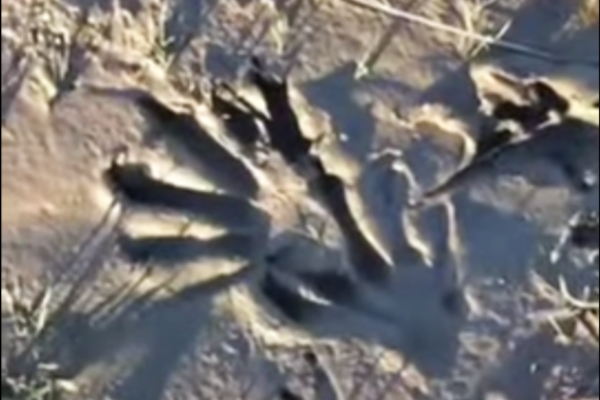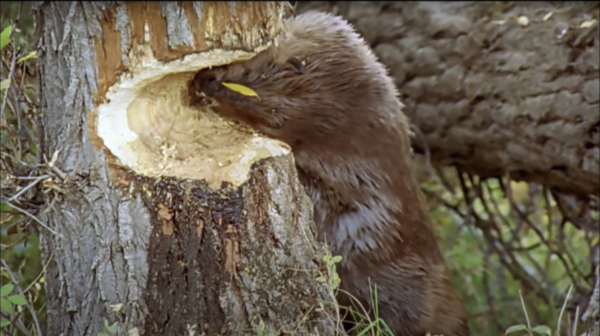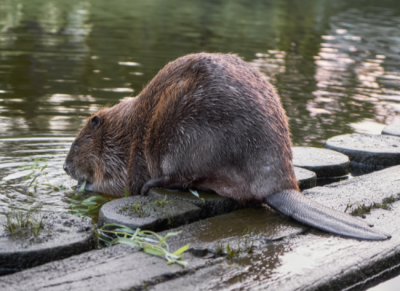Identification
Beaver Identification
Beavers are a common species in North America and also the biggest rodent on the continent, weighing around 45-60 pounds (although some can weigh as much as 100 pounds). They are beautiful creatures with webbed feet, thick fur, and clever instincts. If you happen to live near a lake, pond, or stream, you may even get the privilege of being in the presence of their beauty, or maybe you’ve already seen one swimming around or seen one of their dams while out for a walk. Here are some other ways to tell if a family of beavers might be in your area:
Vocalization and Body Language
Beaver calls are low-pitched and nasally (similar to the way a duck sounds), but they are not known to be very vocal animals. Despite this, their voices are actually a way for them to tell each other apart. Another way they differentiate each other and communicate is through their tails. Besides communication, their tails also serve a couple of other purposes, such as keeping them balanced while they’re swimming, sitting, and standing, and their tails even store extra body fat during the winter. Going back to their methods of communication, beavers use their tails to talk to one another through a concept called “tail-slapping”, which is exactly what it sounds like. You’ve probably seen them do this in nature documentaries or cartoons growing up.
A beaver can slap their tail for a few different reasons, such as warning other beavers about imminent danger, warding away predators (foxes, hawks, coyotes, otters, owls, etc.), startling enemies in order to pinpoint their enemies’ locations, and even a reason as simple and innocent as initiating play with other beavers. Here’s a fun fact: female beavers are known to slap their tails more than male beavers. So if you’re out fishing or hiking and hear a loud splash, there may be a beaver nearby.
Droppings
Similar to other animals, beavers can recognize one another through the scent emitted by their fecal matter, which takes on a sawdust-like appearance. They also use their defecation to mark their territory, but their scat is usually only in or near the water close to their homes, so you probably won’t see any if you happen to be near a family of them unless you’re close to the edge of whatever stream, lake, pond, etc. that you’re visiting.
To be more specific about how they mark their territory, they have castor glands below their abdomens where they produce castor, which is a musky oil with a strange vanilla-like scent that they use to groom themselves and show ownership of their homes. This substance is also what makes their fur waterproof. Here’s another fun fact that you may or may not know: castor is used in a lot of our foods and perfumes, and it is priced at an estimated $70 per pound.
Tracks

It’s no surprise that beavers are such good swimmers. As previously mentioned, their feet are webbed, which helps them stay afloat, like their tails. Their feet are also pretty distinct, compared to other animals. Their front and hind feet are different sizes, their front feet being 2-3 inches while their hind feet are 6-7 inches.
Their tracks tend to look like large, webbed handprints on the ground but are usually covered by their long tails dragging behind them wherever they go. You’re most likely to find their tracks in muddy areas near water.
Damage

Beavers are most known for their crafty ability to build dams. Typically, they live in or close to ponds, swamps, marshes, rivers, and lakes, so you probably won’t find one in a desert any time soon. In these wet environments, they usually build dome-like wooden structures for their families to live inside, called “lodges”. Their lodges sit above the water and are pretty spacious inside, averaging around eight feet in diameter. They build their homes and dams using rocks, moss, mud, grass, sticks, and most importantly: their teeth. It’s no secret that beavers have such large and powerful teeth since they need them to “chop” as much wood as they do.
Their teeth are orange (from the enamel) and razor-sharp, specifically adapted for breaking through wood with ease. They can easily chop down whole trees, using only their teeth when working together. Live Science states that, on average, a beaver’s teeth are 20-25mm, but they continue to grow throughout the beaver’s life. Unfortunately, their powerful teeth and amazing crafting abilities tend to collide with our way of life at times. Whenever they create their dams near a river, the blockage of the stream can create a pond. This is the perfect environment for them, but it can be problematic for us.
These ponds can overflow, which causes floods in surrounding areas. The government has been searching for ways to put a stop to this without hurting the beavers, especially since beavers were once close to extinction due to people hunting them for their meat and fur. They hope to find a way for both beavers and people to safely live together in harmony.
Beavers are amazing animals with a very interesting way of life. It’s difficult not to marvel at their intelligence when you happen to cross paths with them. They are one of the most intriguing and skilled animals in North America.

